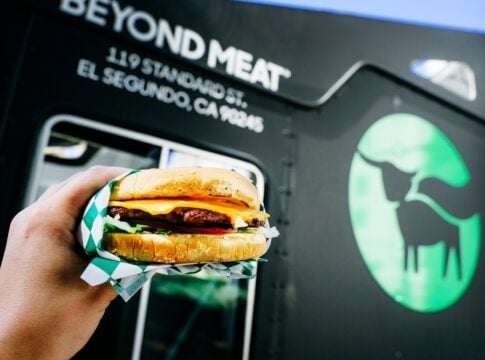Beyond Meat is back in the spotlight. The plant-based meat company has seen a sharp rise in its share price after announcing a major U.S. retail expansion. It revealed that its products would now be sold in more than 2,000 Walmart stores. The company also launched a new Beyond Burger 6-Pack, giving shoppers a more affordable way to buy plant-based meat.
But this comeback is about more than business. Beyond Meat’s biggest story lies in its climate and sustainability record, which continues to set it apart from traditional meat producers.
A Massive Stock Rebound
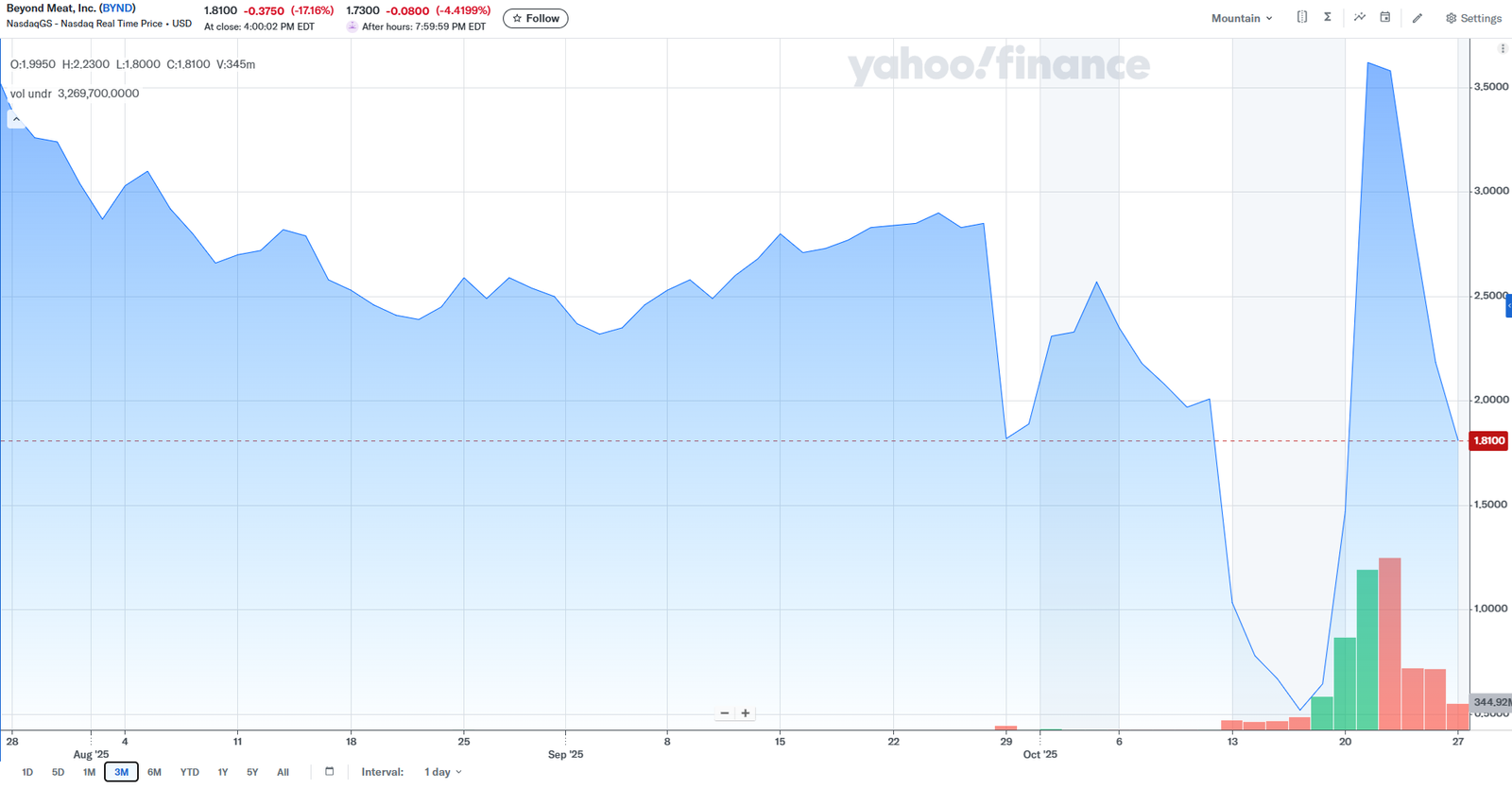
Beyond Meat’s stock surge surprised both analysts and investors. The sharp jump came after months of slow trading and declining confidence in plant-based food stocks.
Over a three-day trading period, Beyond Meat experienced a remarkable surge of nearly 600%, with its share price increasing from $0.52 on October 16 to a peak of $3.62 on October 21. By October 27, the stock had settled at $1.81, reflecting ongoing volatility and heightened market interest.
Analysts say the rally reflects renewed trust in Beyond Meat’s growth strategy, especially its partnership with Walmart and the introduction of lower-priced products. The move shows how the company plans to reach more households and expand in a challenging grocery market.
Market data show Beyond Meat’s market capitalization climbed by billions of dollars in less than a week. The rally also sparked fresh interest from institutional investors looking at sustainability-driven food companies.
Even after the rapid rise, analysts note that Beyond Meat remains a volatile stock. Still, its recovery highlights how strong sustainability credentials and affordable innovation can reignite investor enthusiasm.
Huge Reductions in Emissions and Resource Use
Beyond Meat’s latest life cycle assessments (LCAs) show how much cleaner its products are compared to beef.
- Making a Beyond Burger creates 90% fewer greenhouse gas emissions than a beef burger of the same size.
- It uses 97% less water, 93–97% less land, and up to 65% less energy.
- One Beyond Burger has a carbon footprint of 0.68 kilograms of CO₂e, about 38 times smaller than beef.
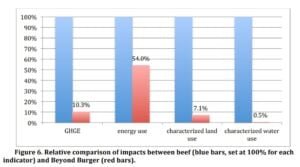
These results come from studies done by the University of Michigan and reviewed by independent experts. The reason for the low impact is simple.
Beyond Meat’s ingredients — such as peas, rice, and canola — take far fewer resources to grow than raising cattle. Cows also release methane, a gas far more powerful than CO₂, which plants do not produce.
Steak Without the Guilt: Cutting Emissions by 84%
Beyond Meat’s new Beyond Steak also shows strong environmental performance. The product emits 84% less greenhouse gas and uses 93% less water than a beef steak.
The company says if every American swapped one beef meal a week for a Beyond Meat product, it could cut emissions equal to taking 12 million cars off the road each year.
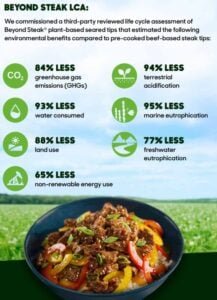
Food production creates about 1/3 of global greenhouse gas emissions, according to the United Nations. Plant-based meat helps lower that total, making a diet change one of the fastest ways to fight climate change.
Below is the chart showing the carbon footprint of different food products per kilogram:
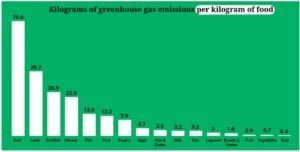
How Beyond Meat Builds Its ESG Strategy
Beyond Meat’s commitment to sustainability goes beyond its products. The company’s ESG plan focuses on clean operations, better packaging, and responsible sourcing.
- Renewable power: Some of its factories already run on clean electricity. The company plans to expand this each year.
- Sustainable sourcing: Ingredients come from farms that use less water and fewer fertilizers.
- Greener packaging: Beyond Meat has reduced plastic use and added more recyclable materials.
- Water savings: Compared to beef, its products need only a small fraction of the water to produce.
In its latest ESG report, Beyond Meat said it had cut its operational carbon footprint by over 20% in just two years. Its total GHG emissions reached about 193,700 metric tons of CO₂e across all scopes. This includes 7,999 tCO₂e from Scope 1, 9,065 tCO₂e from Scope 2 (market-based), and 176,654 tCO₂e from Scope 3 activities such as purchased goods and services.
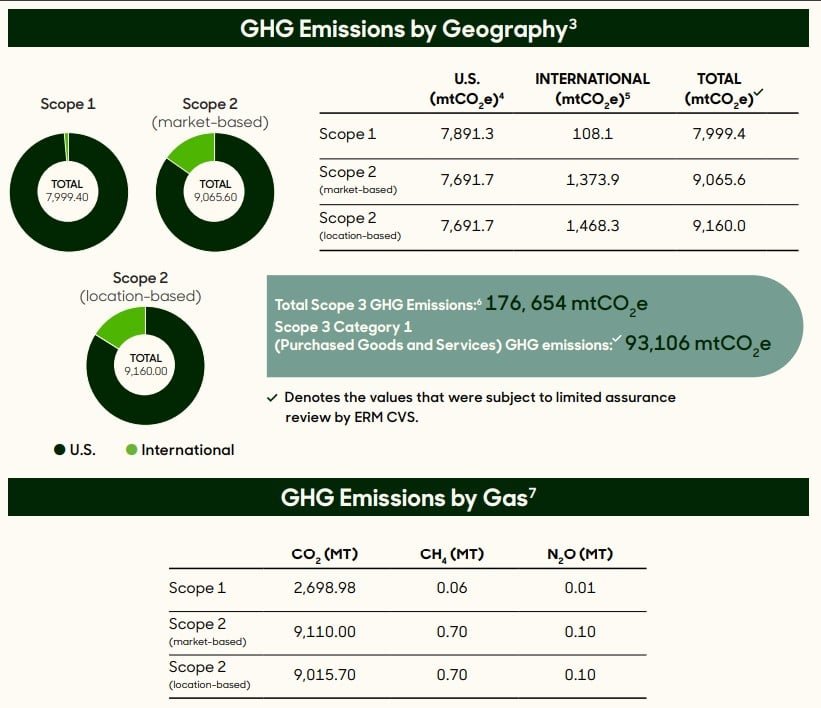
Helping Global Climate Goals
Beyond Meat’s model supports the Paris Agreement’s goal to limit global warming to 1.5°C. Livestock farming creates nearly 15% of global emissions, mostly from methane. Replacing even part of the global meat market with alternatives would have a big impact.
Analysts at Boston Consulting Group (BCG) estimate that if 10% of all meat sold by 2030 were plant-based, it could cut 0.5 gigatons of CO₂e each year.
By expanding through Walmart, Target, and other retailers, Beyond Meat is helping make climate-friendly food more common and affordable.
Business Growth and Climate Impact
Beyond Meat’s recent recovery also matches a growing global market for sustainable food. Plant-based food sales hit $52 billion in 2024 and could reach over $160 billion by 2030, according to Bloomberg Intelligence.
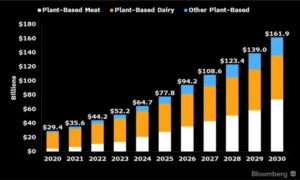
Investors are increasingly focused on ESG performance. Beyond Meat’s verified environmental data makes it attractive for both climate-conscious investors and everyday consumers.
The company’s new six-pack burger is a big part of that effort. It offers lower prices during a time when food inflation is high, helping more people choose climate-friendly protein without paying extra.
Setting Standards in Sustainability Reporting
Beyond Meat stands out for being open about its environmental data. It reports its progress through international standards like the Sustainability Accounting Standards Board (SASB) and the Carbon Disclosure Project (CDP).
In 2024, it ranked among the top 5% of food companies worldwide for sustainability transparency, according to Corporate Knights. The company also works with industry groups and governments to improve standards for labeling and emissions reporting.
Beyond Meat’s supply chain data show how its focus on transparency helps build trust with retailers and regulators. Investors view this as a sign of long-term stability and accountability.
New Challenges, Same Mission
Beyond Meat’s journey has not been easy. The plant-based meat market is becoming more competitive, and consumer demand has been uneven in recent years. Some shoppers still prefer the taste or texture of beef.
To respond, Beyond Meat is improving its recipes and investing in research. It is also testing regenerative farming methods to grow its crops in ways that store carbon and improve soil health. These efforts could make its ingredients even more climate-friendly.
Price remains another challenge. Plant-based meat often costs more than beef. However, the new value-sized burger pack and wider retail reach aim to close that gap and attract new buyers.
Beyond Meat’s stock surge marks more than a financial rebound; it signals renewed faith in sustainable food innovation. As global emissions rise, Beyond Meat shows how small choices, like swapping one meal, can add up to real change.
Every Beyond Burger or Beyond Steak sold saves water, reduces land use, and lowers carbon pollution. The company proves that business growth and sustainability can go hand in hand and that the future of food can be both profitable and planet-friendly.
The post Beyond Meat’s Comeback: 600% BYND Stock Surge Fuels Its Climate Revival appeared first on Carbon Credits.

